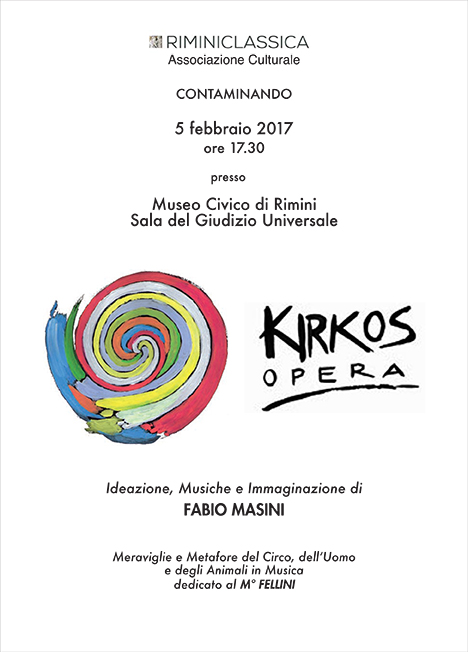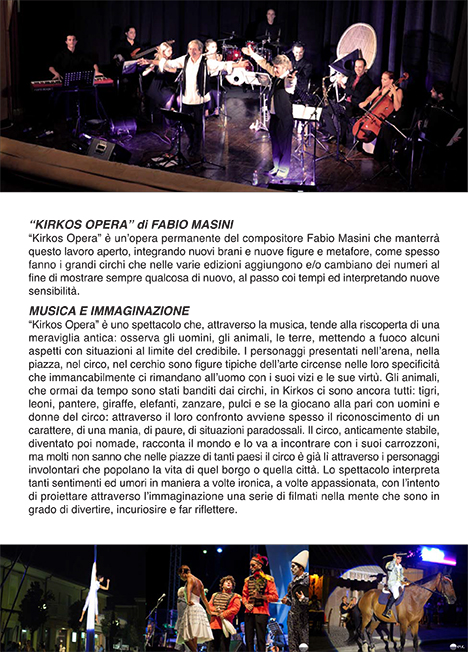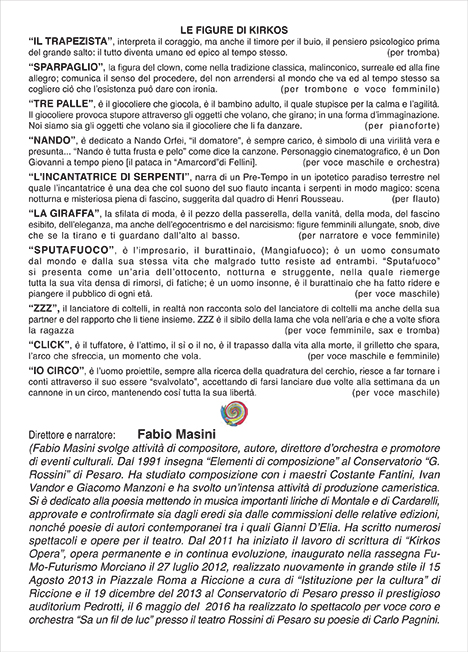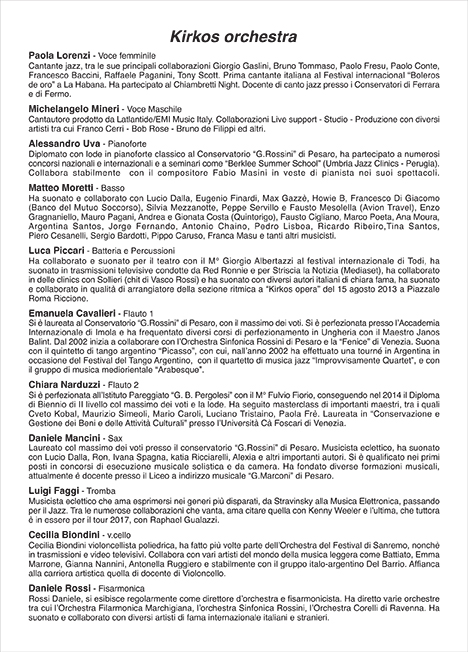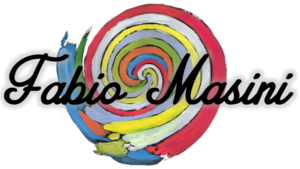Kirkos opera
Anni 2012-2017 ...WORK IN PROGRESS...
Kirkos Opera – Musica e Immaginazione
Kirkos è uno spettacolo che, attraverso la musica, tende alla riscoperta di una meraviglia antica: osserva gli uomini, gli animali,le terre,mettendo a fuoco alcuni aspetti, con situazioni a volte al limite de credibile.
ai personaggi che vengono presentati nell’arena, nella piazza, nel circo, nel cerchio e nel cilindro sono figure tipiche dell’arte circense nelle loro specificità, ma che immancabilmente ci rimandano all’uomo con i suoi vizi e le sue virtù.
Gli animali, che ormai da tempo sono stati banditi dai circhi, in Kirkos ci sono ancora tutti: tigri,leoni,pantere,giraffe,elefanti,zanzare,pulci e se la giocano alla pari con gli uomini e donne del circo, perchè proprio attraverso il loro confronto avviene spesso il riconoscimento di un carattere, di una mania, di paure, di situazioni paradossali.
Il circo è nomade, racconta il mondo e lo va ad incontrare con i suoi carrozzoni, ma molti non sanno che nelle piazze di tanti paesi il circo è già lì, attraverso i loro personaggi involontari che popolano la vita di quel borgo o città che sia.
Kirkos racconta l’uomo attraverso il coraggio del Trapezista o del tuffatore, la tenerezza, la goffaggine, l’inadequatezza del clown Sparpaglio (con riferimenti ai grandi del cinema come TOTO’ e CHAPLIN), la proiezione, attraverso il giocoliere “Tre palle” che tiene tutti col naso all’insù o con il domatore “NANDO” che sussurra alla pantera ” fai piano che c’è gente, non farmi fare brutte figure!”
Lo spettacolo attraversa tanti sentimenti ed umori in maniera a volte ironica, a volte appassionata, con l’intento di proiettare attraverso l’immaginazione una serie di filmati della nostra mente che ci possano divertire ed incuriosire.
Lo spettacolo può essere realizzato nelle piazze con una band di 25 musicisti, 3 cantanti, mimi, artisti circensi e cavalieri.
Lo spettacolo per i teatri sarà ridotto solo nel numero dei partecipanti, tenendo conto delle esigenze dello spazio, pur mantenendo per intero la struttura e il divertimento, coinvolgendo in più occasioni il pubblico stesso.
Lo spettacolo/presentazione (per piccoli spazi) si avvale della presenza dell’autore e direttore e di 3/4 musicisti e viene realizzato in forma di laboratorio, coinvolgendo gli spettatori che vorranno mettersi in gioco.
Kirkos Opera – Music and Imagination
Kirkos is a show that, through music, tends to the rediscovery of an ancient wonder: observing men, animals, lands, focusing on certain aspects, situations that sometimes may be unbelievable.
The characters that are presented in the arena, in the square, in the circus, in the circle and cylinder are typical figures of circus art in their specificity, but which inevitably remind us of “ man “with his vices and his virtues.
The animals, which has long been banned from circuses, can still be found in Kirkos: tigers, lions, panthers, giraffes, elephants, mosquitoes, fleas, and they play with men and women of the circus, because through their comparison we may see a character, a mania, fears or paradoxical situations.
The circus is nomadic, it tells about world and goes to meet it with his wagons, but many do not know that in the streets of many countries, circus is already there, through their involuntary characters that populate the life of that village or city.
Kirkos tells the man through the courage of the Trapeze or digger, tenderness, clumsiness, the inadequacy of the clown SPARPAGLIO (with references to the great film artists like TOTO ‘and CHAPLIN), the projection through the juggler “Three Balls” that keeps everyone interested or the tamer “NANDO” whispering to the Panther “be silent!!!there are people looking at us, do not make me look bad!”
The show runs through many feelings and moods that are sometimes humorous, sometimes passionate, with the intent of projecting the imagination through a series of movies in our mind that we can entertain and intrigue.
The show can be carried out in the streets with a band of 25 musicians and 3 singers, mimes, circus performers and riders.
The show will be reduced to the theaters only in the number of participants, taking into account the needs of the space while maintaining its structure and fun, involving on more occasions the audience itself.
The show / presentation (for small spaces) relies on the presence of the author and director and three quarters musicians and is realized in the form of a workshop, involving the audience who want to get into the performance.
“Kirkos opera” è un’opera permanente del compositore Fabio Masini il quale manterrà questo lavoro aperto, integrando nuovi brani e nuove figure e metafore ,come spesso fanno i grandi circhi che nelle varie edizioni aggiungono e/o cambiano dei numeri al fine di mostrare sempre qualcosa di nuovo al passo coi tempi, ed interpretando nuove sensibilità.
Il “Kirkos” del 2012 è stato dedicato al movimento culturale Futurista italiano utilizzando alcune trovate teatrali tipiche delle avanguardie del movimento e mettendo in contatto le sintesi del circo con quelle del movimento culturale in questione.
“Kirkos 2013” ha raccontato il clown e quindi il circo attraverso gli occhi del grande regista Federico Fellini, lasciando nello spettacolo stesso molto di quel mondo visionario e immaginifico tipico dell’opera del maestro riminese.
“Kirkos opera 2014” sarà dedicato ad Astley, ufficiale della cavalleria britannica dal 1759, il quale tornato dalla guerra dei sette anni inventerà il primo circo moderno.
Quindi quest’anno è dedicato al cavallo, alla cavalleria, e attraverso il cavallo la circolarità del circo per le necessità dei numeri equestri.
Quest’anno ricorrono i 200 anni dalla morte dell’ufficiale e inventore del circo moderno Astley, per questa nobile ragione “Kirkos opera” sarà dedicato ad Astley ,non solo come cavallerizzo ma anche quale inventore del più grande spettacolo del mondo: IL CIRCO.
Il cerchio , il cavallo, la forma circolare del circo.
Il cavallo: eleganza, potenza, velocità e leggerezza.
I bozzetti per lo studio del cavallo di Leonardo Da Vinci, le muscolature,
Il circo attraverso il raffinatissimo cavallerizzo Astley sino al leggendario Buffalo Bill, rude e potente, il quale neppure lui riuscì a sfuggire al fascino del circo, in questo caso quello nomade.
Cavalli , uomini, piste , circhi in muratura prima e in forma itinerante poi, con tanto di tendoni e carrozzoni.
Astley aveva capito che cavalcando in cerchi a gran velocità, si riusciva a stare in piedi sulla sella ,già dal 1768 cominciò ad esibirsi in pubblico in un campo all’aperto.
Poco tempo dopo Astley costruì sul posto il primo anello circense, che in meno di dieci anni diventò un vero e proprio anfiteatro dotato di palcoscenico, orchestra, palchi e galleria.
All’inizio Astley era l’unica attrazione dell’ AMPHITHEATRE, il suo numero caratteristico era quello di alzarsi in piedi con un piede sulla sella e uno sulla testa dell’animale, brandendo una spada al vento.
Poi incluse numeri d’altri cavallerizzi, acrobati, danzatori, clowns ,costituendo così di fatto il circo nella forma moderna come ancora oggi lo conosciamo.
Il successo e la popolarità di Astley furono tali da ricevere il patronato del Principe di Galles e del Duca di York nel 1794, il suo circo passò a chiamarsi The Royal Amphitheatre, nome che fu mantenuto nel periodo dal 1804 al 1823.
L’influsso di Philip Astley sull’industria dello spettacolo non si limitò al Regno Unito: già dal 1772 Astley faceva numerosi tour fra varie città europee, inclusa Parigi, dove si esibì al cospetto del re di Francia e della sua corte reale.
Sempre a Parigi costruì un secondo Amphitheatre nel 1782, oltre a 18 circhi permanenti nel resto d’europa.
Ogni anno che “Kirkos opera” riparte rinnovandosi a seconda dei momenti e dei luoghi dove lo si realizza, di anno in anno capitalizza una sorta di eredità concettuali e di stili trattenendo le cose più importanti delle precedenti edizioni, del tipo:
(2012) Cosa può voler dire oggi Futurista? Cosa c’è di Futurista in Kirkos?
(2013) Cosa vuol dire “Felliniano”? Cosa c’è di Felliniano in Kirkos?
(2014) quest’anno lo studio del cavallo di Leonardo Da Vinci,
L’epica del cavallerizzo Astley, dalla grande guerra dei sette anni all’invenzione del circo ( dalla guerra al gioco)
“Kirkos work” is a permanent work of the composer Fabio Masini
who will keep this work open, integrating it with new songs and new figures and metaphors, as they often do large circuses in the various editions that add and / or change the numbers in order to show something new up to date, and interpreting new sensitivity .
“Kirkos” 2012 was dedicated to the Italian Futurist cultural movement using some typical theatrical figuresof the avant-garde movement and by contacting the synthesis of circus with those of the cultural movement in question.
“Kirkos 2013 ‘ told about the clown and circus seen through the eyes of the great film director Federico Fellini, leaving in the show itself much of that visionary and imaginative world, typical of the master of Rimini.
“Kirkos 2014” is being dedicated to Astley, British chevalry officer since 1759, who returned from the Seven Years’ War and was the inventor of the first modern circus.
So this year is dedicated to “ horse”, chevalry, and the circularity of circus, necessary for many performances.
This year marks the 200th anniversary of the death of the officer and inventor of the modern circus Astley, for this noble cause “Kirkos opera” will be dedicated to Astley, not only as a rider but also as the inventor of the greatest show on earth: CIRCUS.
The circle, the horse, the circular shape of the circus.
The horse: elegance, power, speed and lightness.
The sketches for the study of the horse by Leonardo Da Vinci, the musculature,
Circus through the refined rider Astley until the legendary Buffalo Bill, rough and powerful, who even managed to escape from the charm of circus, in this case the nomad.
Horses, men, tracks, circuses masonry first and then in itinerant form, complete with tents and caravans.
Astley had realized that riding in circles at high speed, you could stand up in the saddle,and already from 1768 he began to perform in public in an open field.
Shortly after, Astley built the first ring circus, that in less than ten years became a real amphitheater with a stage, orchestra, stage and gallery in less than ten years.
Earlier Astley was the only attraction of ‘AMPHITHEATRE, its characteristic number was to stand up with one foot on the seat and one on the head of the animal, brandishing a sword in the wind.
Then including numbers of other riders, acrobats, dancers, clowns, thus constituting in fact the circus in modern form as we know it today.
The success and popularity of Astley were such as to receive the patronage of the Prince of Wales and the Duke of York in 1794, his circus came to be called The Royal Amphitheatre, a name that was maintained during the period 1804-1823.
The influence of Philip Astley industry of the show was not limited to the United Kingdom: from 1772 Astley had already made numerous tours in various European cities, including Paris, where he performed at the presence of the King of France and his royal court.
Still in Paris, he built a second Amphitheatre in 1782, in addition to the 18 permanent circuses in the rest of Europe.
Every year that “Kirkos Opera” renews itself depending on the time and place where it is carried out, year after year it capitalizes a kind of conceptual inheritance of styles and retaining the most important things of previous editions, such as:
(2012) What can Futurist mean today? What’s Futurist in Kirkos?
(2013) What does “Fellinian” mean? What is there of Fellini in Kirkos?
(2014) this year the study of the horse by Leonardo Da Vinci
The epic horseman Astley, from the great Seven Years’ War to the invention of the circus (war-gaming)
The Italian challenges of Buffalo Bill together with Sitting Bull to introduce the Italian tour circus of which he was the main character.
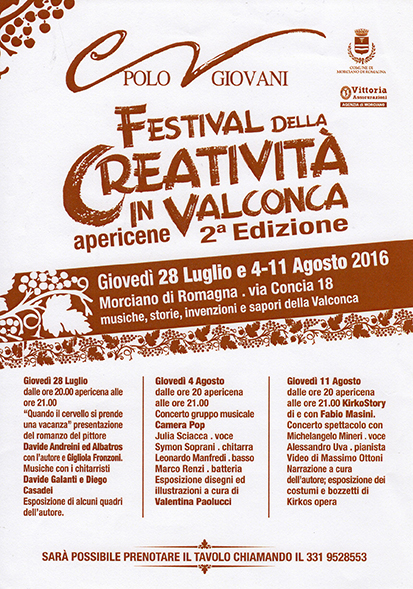
11 agosto 2016 ore 21.00
Festival della Creatività in Valconca, 2 edizione
Polo giovani – Sala Polivalente Morciano di Romagna
“kirkoStory”
Di e con Fabio Masini
concerto/spettacolo con voce – Michelangelo Mineri
Pianoforte – Alessandro Uva
e con esposizione delle musiche, costumi e bozzetti dell’autore
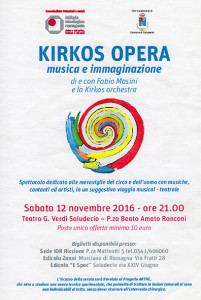
12 novembre 2016 ore 21.00
Teatro Verdi – Saludecio (RN)
Istituto Oncologico Romagnolo e Comune di Saludecio
“Kirkos Opera”
musica e immaginazione
Di e con Fabio Masini
e la Kirkos Orchestra
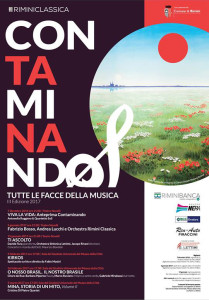
5 Febbraio 2017 ore 17.30
Rimini Classica – Associazione Culturale – “Contaminando”
Museo Civico di Rimini
Sala del Giudizio Universale
“Kirkos Opera 2017”
Di e con Fabio Masini
e la Kirkos Orchestra
